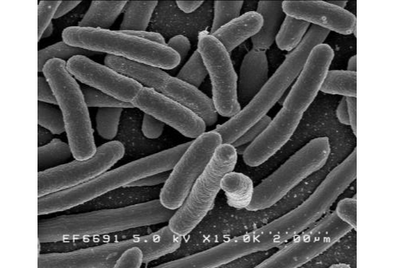Korarchaeum cryptofilum
Introduction
Candidatus Korarchaeum cryptofilum is a species of the proposed phylum Korarchaeota, or Xenarchaeota of the Archaea. The phylum is notoriously difficult to study given the environment in which it lives.[1] The Archean phylum is found mainly in hydrothermal environments such as hot springs, shallow water, and deep ocean. The organism's genome has mainly been studied to open understanding of Archaean evolution due to its distant detachment on the Archaea phyla.

Discovery
The phylum Korarchaeota was only recently discovered in 1996 by a team studying Archaea in hot springs located in Yellowstone National Park. By sequencing the ribosomal RNA of many uncultivated archaeans found in a hot spring, two outlying sequences were found. The two outlying sequences were used as evidence for the proposal of a new phylum "Korarchaeota"[2]
Genetics and Structure
Korarchaeum cryptofilum is an ultrathin filamentous[2] autotroph, mostly living through anaerobic metabolism of peptide fermentation and protein broken to H_2. The organism uses enzymes such as peptidase, transaminases, and ATPase. [1]
The genome of Ca. K. cryptofilum is 1,590,757 base pairs long with an average G+C content of 49%. The arCOG of the archaean phyla crenarchaeota and euryarchaeota when compared with the sequenced genome of Ca. K. cryptofilum, showed that the organism shares its replication, recombination, repair, and cell division genes with that of crenarchaeota while it shares most of its transcription and translation genes with euryarcahaeota.
[3] The unusual similarity to Crenarchaeota and Euryarchaeota in the archaeons genome suggest its genome has "retained features that represent an ancestral archaeal form, existing before the occurence of the evolutionary bifurcation into Crenarchaeota and Euryarchaeota"[4].
Ca. K. cryptofilum has three rRNA genes (16S, 23S, and 5S rRNA). The organism has shown to produce 33 23S r-proteins and 27 16S r-proteins on its rRNA operon. The species is also found to have 45 tRNA genes on its genome with one initiator and 45 elongator tRNAs.[3][5]
Microbiome
The Microbiome of Candidatus Korarchaeum cryptofilum is extreme compared to humans. The archaeon is found
Include some current research, with a second image.
The population of the Korachaeota is generally minute in its microbiome living in the biome. However in some cases they constitute 7% of all Archaea.[6]
Conclusion
References
- ↑ 1.0 1.1 Nealson, Ken. “A Korarchaeote yields to genome sequencing.” Proceedings of the National Academy of Sciences of the United States of America vol. 105,26 (2008): 8805-6. doi:10.1073/pnas.0804670105
- ↑ 2.0 2.1 [https://www.ncbi.nlm.nih.gov/pmc/articles/PMC2430366/?tool=pmcentrez&report=abstract Barns, S M et al. “Perspectives on archaeal diversity, thermophily and monophyly from environmental rRNA sequences.” Proceedings of the National Academy of Sciences of the United States of America vol. 93,17 (1996): 9188-93. doi:10.1073/pnas.93.17.9188
- ↑ 3.0 3.1 > Miller-Coleman, Robin L et al. “Korarchaeota diversity, biogeography, and abundance in Yellowstone and Great Basin hot springs and ecological niche modeling based on machine learning.” PloS one vol. 7,5 (2012): e35964. doi:10.1371/journal.pone.0035964
- ↑ Baltscheffsky, H. & Persson, B. J Mol Evol (2014) 78: 140
- ↑ James G et al. “A korarchaeal genome reveals insights into the evolution of the Archaea.” Proceedings of the National Academy of Sciences of the United States of America vol. 105,23 (2008): 8102-7. doi:10.1073/pnas.0801980105
- ↑ Reigstad, Laila Johanne, et al. “Diversity and Abundance of Korarchaeota in Terrestrial Hot Springs of Iceland and Kamchatka.” ISME Journal: Multidisciplinary Journal of Microbial Ecology, vol. 4, no. 3, Mar. 2010, pp. 346–356. EBSCOhost, doi:10.1038/ismej.2009.126.
Edited by [Charlie Stutz], student of Joan Slonczewski for BIOL 116 Information in Living Systems, 2019,
